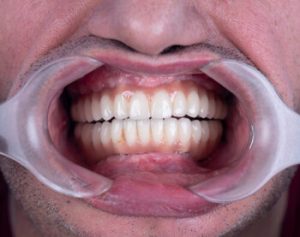
Do you ever feel self-conscious when you smile because your gums seem to take center stage? If your smile shows more gum tissue than you’d like, you might have what’s commonly called a gummy smile. While some people embrace it with confidence, others seek ways to achieve a more balanced appearance. The good news is, you can fix a gummy smile with the help of modern dental care.
This guide walks you through everything you need to know about how to fix a gummy smile, from what causes it to the most effective treatment options available today.
 What is a gummy smile?
What is a gummy smile?
A gummy smile, also known as excessive gingival display, happens when too much gum tissue is visible above your upper teeth when you smile. Though there’s no medical problem with this condition, many people feel self-conscious about the way it looks. Dental professionals usually consider a smile gummy if more than two to three millimeters of gum tissue shows above the upper teeth.
What causes a gummy smile?
A variety of factors can cause a gummy smile. Identifying the root cause is crucial for selecting the most effective treatment. Here are some common reasons:
Excess gum tissue
Some people naturally have too much gum tissue covering their teeth, which makes the teeth look shorter and the gums more prominent.
Abnormal tooth eruption
If your permanent teeth didn’t erupt correctly, they might still be partially covered by gum tissue. This can contribute to an unbalanced gum-to-tooth ratio.
Hyperactive upper lip
A hyperactive upper lip lifts too high when you smile. This over-contraction of the upper lip muscles exposes more of your gums than usual.
Short upper lip
If your upper lip is naturally shorter, it may not cover the upper gums adequately, causing a more pronounced gummy smile.
Vertical maxillary excess
This condition refers to the excessive development of the upper jaw, which can cause the gums to be pushed down and forward, exposing excessive gum tissue when you smile.
Bad bite or jaw misalignment
A bad bite, also known as malocclusion, can cause the jaw and teeth to sit in a way that makes your smile show more gums.
How to fix a gummy smile: Treatment options
Fixing a gummy smile depends on the cause. Treatment options range from simple, non-invasive methods to more complex surgical procedures. Here’s a look at the most effective ways to fix a gummy smile.
Laser gum contouring
Laser gum contouring is a popular and minimally invasive procedure used to reshape the gum line. Special dental lasers are used to trim away excess gum tissue, revealing more of your natural teeth.
- Ideal for: People with excess gum tissue or abnormal tooth eruption
- Procedure time: 30 to 60 minutes
- Recovery: A few days to a week
- Benefit: Permanent results with minimal discomfort
Crown lengthening
Crown lengthening is a surgical procedure where both gum tissue and sometimes bone are removed to expose more of the tooth’s surface. This technique is often used when there’s too much gum or when there’s a need for dental restorations.
- Ideal for: Severe cases with excess gum and bone tissue
- Recovery: 1 to 2 weeks
- Benefit: Improves both function and aesthetics
Lip repositioning surgery
Lip repositioning surgery is a minimally invasive way to address a hyperactive upper lip. The procedure repositions the upper lip to limit its upward movement when you smile, thereby reducing the amount of visible gum tissue.
- Ideal for: People with a hyperactive or short upper lip
- Recovery: Around one week
- Benefit: Reduces excessive gingival display without affecting natural movement
Orthodontic treatment
If your gummy smile is caused by a jaw alignment issue or a bad bite, orthodontic treatment may be the solution. Braces or clear aligners can gradually shift the teeth and jaw into a more ideal position.
- Ideal for: Malocclusion or misaligned jaws
- Treatment length: Several months to years
- Benefit: Long-term improvement of both function and smile appearance
Botox injections
Injecting Botox into the upper lip muscles can limit how much the lip moves when you smile. This helps reduce the visibility of the gums, especially in cases caused by a hyperactive upper lip.
- Ideal for: Mild gummy smiles
- Results last: 3 to 6 months
- Benefit: Quick, reversible, and non-surgical
Porcelain veneers
In some cases, porcelain veneers can be used to make the teeth appear longer and more proportionate to the gums. This can help balance out a mild gummy smile, especially when combined with minor gum contouring.
- Ideal for: Minor cosmetic cases
- Benefit: Improved aesthetics and added tooth strength
What happens during treatment?
 The first step is always a consultation with your dentist or cosmetic specialist. They’ll evaluate your gum tissue, teeth, lips, and jaw to determine what’s causing the gummy smile. You may need imaging or digital scans for precise measurements. Once the cause is clear, your dental team will recommend the most suitable treatment plan.
The first step is always a consultation with your dentist or cosmetic specialist. They’ll evaluate your gum tissue, teeth, lips, and jaw to determine what’s causing the gummy smile. You may need imaging or digital scans for precise measurements. Once the cause is clear, your dental team will recommend the most suitable treatment plan.
Recovery and aftercare depend on the treatment. Laser gum contouring and Botox offer fast recovery, while surgical procedures like crown lengthening or jaw surgery may require more downtime. Your dentist will provide personalized aftercare instructions to ensure proper healing.
When should you consider fixing a gummy smile?
If your gummy smile makes you feel self-conscious or affects how you speak, chew, or clean your teeth, it may be time to consider treatment. Fixing a gummy smile isn’t just cosmetic—it can also improve your oral health by reducing gum pockets that trap bacteria.
Frequently asked questions
What causes a gummy smile?
A gummy smile may be caused by excess gum tissue, abnormal tooth eruption, a hyperactive upper lip, or jaw growth issues like vertical maxillary excess.
Can a gummy smile go away on its own?
No, a gummy smile typically doesn’t resolve without treatment, but some mild cases can be managed with non-surgical options.
Is laser gum contouring safe?
Yes, it’s a safe and common procedure performed by dental professionals using special lasers that target and trim the gum tissue with precision.
How long does recovery take after gum contouring?
Most people heal in about a week. Mild swelling and discomfort are normal but manageable with basic aftercare.
Can I combine treatments?
Yes, in many cases, a dentist may recommend a combination approach. For example, orthodontic appliances followed by gum contouring, for optimal results.
 Final thoughts: You deserve to love your smile
Final thoughts: You deserve to love your smile
A gummy smile is nothing to be ashamed of, but if it’s something that bothers you, there are many ways to change it. From quick fixes like Botox to more lasting solutions like laser gum contouring or orthodontic treatment, you have options.
Choosing to fix a gummy smile is a personal decision. Talk to your dentist about what’s right for you. With the right approach, you can achieve a more balanced and beautiful smile that makes you feel great every time you show it.
References:
https://www.ncbi.nlm.nih.gov/books/NBK470437/
https://www.sciencedirect.com/science/article/pii/S1073874624000033
https://www.colgate.com/en-us/oral-health/mouth-and-teeth-anatomy/3-treatment-options-for-a-gummy-smile
https://www.healthline.com/health/gummy-smile

